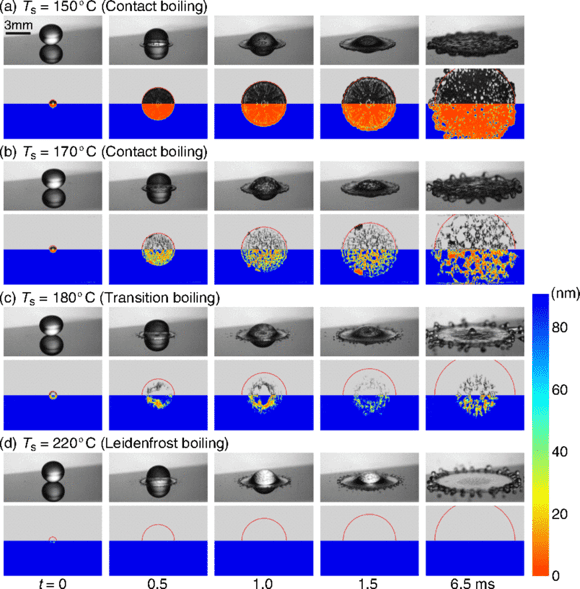If you sprinkle water on a hot plate, it will evaporate. Basic physics, really. If the plate is really hot (well above the boiling point of water) something very interesting happens, which the untrained eye might discard as uneventful. The droplets will dance around the plate on a cushion of its own vapor — this form of levitation is called the Leindenfrost effect. This layer is about 100 nanometers wide, and for the first time a team of researchers has imaged it.

Researchers of the Physics of Fluids group of the University of Twente (MESA+ Institute for Nanotechnology) used high speed cameras and a new technique called internal reflection imaging based on lasers. These lasers can tell if a very small era is wet or dry, in other words if the water droplet is floating above the surface of a pan or on it.

For the experiment, ethanol was used instead of water (makes no difference) under three temperature regimes: contact boiling, transition boiling and Leidenfrost boiling. For each regime, scientists were able to distinguish the incident angle the spreading radius of the droplets. For instance, while transitioning towards Leidenfrost the center part of the droplet will still be in contact with the surface, while oddly the outer ring levitates.
This means that the droplet is not flat, as assumed by most models. Applications where there’s heat transfer from solids to liquids, say in an engine, will benefit the most out of this kind of research. Besides that, it’s always incredible to witness how particles behave at the nanoscale. You don’t see levitation everyday.
It’s important to note that the Leidenfrost effect doesn’t necessarily work at extra boiling point temperatures. The phenomenon works at extremely low temperatures too, as long as there’s a great temperatures difference between the fluid and the other surface. For instance, in the video demonstration below a daredevil sprinkles his hand with water and then dips it in liquid nitrogen for a few seconds. In normal conditions, the hand would have been frozen stiff, but the intense temperature difference between the water at room temperature and liquid nitrogen (-346°F and -320.44°F or 63 K and 77.2 K) creates a thin film barrier protecting the hand. Don’t try this at home!
Reference: ‘Dynamic Leidenfrost Effect: Relevant Time and Length Scales’, by Minori Shirota, Michiel van Limbeek, Chao Sun, Andrea Prosperetti en Detlef Lohse, was published in Physical Review Letters 116 6.
Was this helpful?



